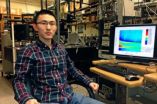(Press-News.org) The ice-free season across the Arctic is getting longer by five days per decade, according to new research from a team including Prof Julienne Stroeve (UCL Earth Sciences). New analysis of satellite data shows the Arctic Ocean absorbing ever more of the sun's energy in summer, leading to an ever later appearance of sea ice in the autumn. In some regions, autumn freeze-up is occurring up to 11 days per decade later than it used to.
The research, published in a forthcoming issue of the journal Geophysical Research Letters, has implications for tracking climate change, as well as having practical applications for shipping and the resource industry in the Arctic regions.
"The extent of sea ice in the Arctic has been declining for the last four decades," says Julienne Stroeve, "and the timing of when melt begins and ends has a large impact on the amount if ice lost each summer. With the Arctic region becoming more accessible for long periods of time, there is a growing need for improved prediction of when the ice retreats and reforms in winter ."
While temperatures have been increasing during all calendar months, trends in melt onset are considerably smaller than that of autumn freeze-up. Nevertheless, the timing of melt onset strongly influences how much of the Sun's energy gets absorbed by the ice and sea. This in turn is affected by how reflective the surface is. Highly reflective surfaces, such as ice, are said to have a high albedo, as they reflect most of the incoming heat back into space. Less reflective surfaces like liquid water have a low albedo, and absorb most of the heat that is directed at them.
This means that even a small change in the extent of sea ice in spring can lead to vastly more heat being absorbed over the summer, leading to substantially later onset of ice in the autumn. There is also a second effect, in that multi-year ice (which survives through the summer without melting) has a higher albedo than single-year ice that only covers the sea in winter. Since the 1980s, the proportion of the Arctic winter ice that is made up of multi-year ice has dropped from around 70% to about 20% today, so the changes are quite substantial
These feedback effects, in which small changes in atmospheric temperature and sea ice lead to large changes in heat absorption, was what the team set out to study.
Stroeve's team analysed satellite imagery of the Arctic region, dating back over 30 years. The data breaks down the whole region into 25x25km squares, and the team analysed the albedo of each of these for each month for which they had data. This allowed them to update trends and add an extra 6 years onto the most recent analysis of its kind. The new data continues the trend towards longer ice-free periods previously observed.
"The headline figure of five days per decade hides a lot of variability. From year to year, the onset and freeze-up of sea ice can vary by about a week. There are also strong variations in the total length of the melt season from region to region: up to 13 days per decade in the Chukchi Sea, while in one, the Sea of Okhotsk, the melt season is actually getting shorter."
The amounts of energy involved in these changes are enormous – hundreds of megajoules of extra energy accumulated in every square metre of sea. This is equivalent to several times the energy released by the atom bomb at Hiroshima for every square kilometre of the Arctic Ocean.
For organisations such as oil drillers operating in the Arctic region, a sophisticated understanding of when the sea will freeze up is essential. For climate scientists, this type of study helps them better understand the feedback mechanisms inherent in the Arctic climate. The results from this study are closely in line with previous work and therefore give added confidence that models of the complex Arctic climate are broadly correct.
INFORMATION:
Notes
The research appears in a paper entitled "Changes in Arctic melt season and implications for sea ice loss", to be published in a forthcoming issue of the journal Geophysical Research Letters. An online pre-print is available now on the journal website.
Julienne Stroeve is a recent appointment to UCL Earth Sciences, joining the department from the National Snow and Ice Data Centre in Colorado, USA.
Science contact
Julienne Stroeve
UCL Earth Sciences and National Snow & Ice Data Center
stroeve@nsidc.org
Media contact
Oli Usher
UCL Faculty of Mathematical and Physical Sciences
020 7679 7964
o.usher@ucl.ac.uk
About UCL (University College London)
Founded in 1826, UCL was the first English university established after Oxford and Cambridge, the first to admit students regardless of race, class, religion or gender and the first to provide systematic teaching of law, architecture and medicine.
We are among the world's top universities, as reflected by our performance in a range of international rankings and tables. According to the Thomson Scientific Citation Index, UCL is the second most highly cited European university and the 15th most highly cited in the world.
UCL has nearly 27,000 students from 150 countries and more than 9,000 employees, of whom one third are from outside the UK. The university is based in Bloomsbury in the heart of London, but also has two international campuses – UCL Australia and UCL Qatar. Our annual income is more than £800 million.
Full text and high-resolution images available from: http://www.ucl.ac.uk/maps-faculty/maps-news-publication/maps1409
http://www.ucl.ac.uk | Follow us on Twitter @uclnews | Watch our YouTube channel YouTube.com/UCLTV
New data confirms Arctic ice trends: Sea ice being lost at a rate of 5 days per decade
2014-03-04
ELSE PRESS RELEASES FROM THIS DATE:
Combination ARV vaginal ring to prevent HIV safe in trial but 1 ARV carries the weight
2014-03-04
BOSTON, March 4, 2014 – An early phase clinical trial of a vaginal ring containing the antiretroviral (ARV) drugs dapivirine and maraviroc found the ring was safe in women who wore it for 28 days and evidence of dapivirine in cervical tissue and blood. In addition, laboratory tests of tissue samples showed that dapivirine was able to block HIV infection, though levels of maraviroc were not sufficient to have a similar effect, reported researchers from the National Institutes of Health-funded Microbicide Trials Network (MTN) today at the 21st Conference on Retroviruses and ...
Behavioral measures of product use didn't measure up in VOICE HIV prevention trial
2014-03-04
BOSTON, March 4, 2014 – A new analysis by researchers from the U.S. National Institutes of Health-funded Microbicide Trials Network (MTN) confirms what they and many others had already assumed: The behavioral measures used for assessing adherence in the VOICE study – an HIV prevention trial that involved more than 5,000 women in sub-Saharan Africa – did not provide accurate information about women's use and nonuse of the products being tested. Their results, which were reported at the 21st Conference on Retroviruses and Opportunistic Infections (CROI) in Boston today, found ...
Meeting face to face vs. meeting on Facebook -- new study on social anxiety
2014-03-04
New Rochelle, NY, March 4, 2014—Nearly a billion people use Facebook, the largest social networking site, but interacting with someone on social media is not the same as meeting them in person. The results of a study to determine whether Facebook exposure increases or reduces arousal during initial face-to-face encounters, especially among socially anxious individuals, are presented in Cyberpsychology, Behavior, and Social Networking, a peer-reviewed journal from Mary Ann Liebert, Inc., publishers. The article is available free on the Cyberpsychology, Behavior, and Social ...
Two studies advance HIV prevention options for women
2014-03-04
Boston (March 4, 2014) — Two early clinical studies of novel HIV prevention products for women — the first combination antiretroviral (ARV) vaginal ring and a vaginal film — show the products to be safe and open the door to product improvements that could expand options for women-initiated prevention tools. The results of both studies were presented today at the 21st Conference on Retroviruses and Opportunistic Infections (CROI).
The combination ring study, known as MTN-013/IPM 026, was conducted by the National Institutes of Health (NIH)-funded Microbicide Trials Network ...
Society of Interventional Radiology: Understand long-term risks of DVT
2014-03-04
FAIRFAX, Va.—Deep vein thrombosis (DVT) often brings with it the risk of post-thrombotic syndrome (PTS), an under-recognized but serious complication that often causes long-term disability for patients. During March's DVT Awareness Month, the Society of Interventional Radiology wants to help patients and family members to better understand the long-term risks of DVT.
DVT, the formation of a blood clot in a deep leg vein, is a grave condition for which doctors have historically focused on its short-term risks. "For years, if someone developed deep vein thrombosis, his ...
Research benefits surgeons making decisions on how to help their patients breathe easier
2014-03-04
A more accurate and successful, yet complex approach used in designing an airplane is now taking off in the health care industry. The end result is helping patients with pulmonary disorders breathe easier, as well as their surgeons in considering novel treatment approaches. Goutham Mylavarapu, a senior research associate in the University of Cincinnati Department of Aerospace Engineering, and Ephraim Gutmark, Ohio Eminent Scholar and UC distinguished professor of aerospace engineering and engineering mechanics, will present their research involving Computational Fluid Dynamics ...
Children with ADHD have higher risk of teenage obesity and physical inactivity
2014-03-04
Children with attention deficit hyperactivity disorder (ADHD) are more likely to become obese and sedentary teenagers, according to new research.
Previous studies have suggested a link between ADHD and obesity, but whether one leads to the other is unclear. One way to better understand the link is to follow children through to adolescence.
The new study, which followed almost 7000 children in Finland, found that those who had ADHD symptoms at age eight had significantly higher odds of being obese at age 16. Children who had ADHD symptoms were also less physically active ...
Physics in 3-D? That's nothing. Try 0-D
2014-03-04
In physics, there's small, and then there's nullity – as in zero-dimensional.
University of Cincinnati researchers have reached this threshold with a special structure that may someday lead to better ways of harnessing solar energy, stronger lasers or more sensitive medical diagnostic devices.
These structures are semiconductor nanowires. UC doctoral student Teng Shi says she and a team of researchers have observed unique optical signatures indicating that electronic excitations within these nanowires can be confined to a zero-dimensional state called a "quantum dot." ...
How 19th century physics could change the future of nanotechnology
2014-03-04
A new twist on a very old physics technique could have a profound impact on one of the most buzzed-about aspects of nanoscience.
Researchers at the University of Cincinnati have found that their unique method of light-matter interaction analysis appears to be a good way of helping make better semiconductor nanowires.
"Semiconductor nanowires are one of the hottest topics in the nanoscience research field in the recent decade," says Yuda Wang, a UC doctoral student. "Due to the unique geometry compared to conventional bulk semiconductors, nanowires have already shown ...
Next step in live-donor uterus transplant project
2014-03-04
In Sweden alone, an estimated 2 000 young women of fertile age cannot become pregnant either because they were born without a womb or lost it later due to disease.
Professor Mats Brännström, researcher at the University of Gothenburg and chief physician, is leading a unique research project aiming to make it possible for these women to have a uterus transplant and then get pregnant.
A decade of research
After more than a decade of research that has been evaluated in almost 40 scientific articles, in May 2012 the research team received permission from the Regional Ethical ...






